Jiahao Yuan
Affordance-R1: Reinforcement Learning for Generalizable Affordance Reasoning in Multimodal Large Language Model
Aug 08, 2025Abstract:Affordance grounding focuses on predicting the specific regions of objects that are associated with the actions to be performed by robots. It plays a vital role in the fields of human-robot interaction, human-object interaction, embodied manipulation, and embodied perception. Existing models often neglect the affordance shared among different objects because they lack the Chain-of-Thought(CoT) reasoning abilities, limiting their out-of-domain (OOD) generalization and explicit reasoning capabilities. To address these challenges, we propose Affordance-R1, the first unified affordance grounding framework that integrates cognitive CoT guided Group Relative Policy Optimization (GRPO) within a reinforcement learning paradigm. Specifically, we designed a sophisticated affordance function, which contains format, perception, and cognition rewards to effectively guide optimization directions. Furthermore, we constructed a high-quality affordance-centric reasoning dataset, ReasonAff, to support training. Trained exclusively via reinforcement learning with GRPO and without explicit reasoning data, Affordance-R1 achieves robust zero-shot generalization and exhibits emergent test-time reasoning capabilities. Comprehensive experiments demonstrate that our model outperforms well-established methods and exhibits open-world generalization. To the best of our knowledge, Affordance-R1 is the first to integrate GRPO-based RL with reasoning into affordance reasoning. The code of our method and our dataset is released on https://github.com/hq-King/Affordance-R1.
Draw ALL Your Imagine: A Holistic Benchmark and Agent Framework for Complex Instruction-based Image Generation
May 30, 2025Abstract:Recent advancements in text-to-image (T2I) generation have enabled models to produce high-quality images from textual descriptions. However, these models often struggle with complex instructions involving multiple objects, attributes, and spatial relationships. Existing benchmarks for evaluating T2I models primarily focus on general text-image alignment and fail to capture the nuanced requirements of complex, multi-faceted prompts. Given this gap, we introduce LongBench-T2I, a comprehensive benchmark specifically designed to evaluate T2I models under complex instructions. LongBench-T2I consists of 500 intricately designed prompts spanning nine diverse visual evaluation dimensions, enabling a thorough assessment of a model's ability to follow complex instructions. Beyond benchmarking, we propose an agent framework (Plan2Gen) that facilitates complex instruction-driven image generation without requiring additional model training. This framework integrates seamlessly with existing T2I models, using large language models to interpret and decompose complex prompts, thereby guiding the generation process more effectively. As existing evaluation metrics, such as CLIPScore, fail to adequately capture the nuances of complex instructions, we introduce an evaluation toolkit that automates the quality assessment of generated images using a set of multi-dimensional metrics. The data and code are released at https://github.com/yczhou001/LongBench-T2I.
Can Pruning Improve Reasoning? Revisiting Long-CoT Compression with Capability in Mind for Better Reasoning
May 20, 2025Abstract:Long chain-of-thought (Long-CoT) reasoning improves accuracy in LLMs, yet its verbose, self-reflective style often hinders effective distillation into small language models (SLMs). We revisit Long-CoT compression through the lens of capability alignment and ask: Can pruning improve reasoning? We propose Prune-on-Logic, a structure-aware framework that transforms Long-CoT into logic graphs and selectively prunes low-utility reasoning steps under self-verification constraints. Through systematic analysis across three pruning strategies -- targeting entire chains, core reasoning, and verification -- we find that pruning verification steps yields consistent accuracy gains while reducing inference cost, outperforming token-level baselines and uncompressed fine-tuning. In contrast, pruning reasoning or all-chain steps degrades performance, revealing that small models benefit not from shorter CoTs, but from semantically leaner ones. Our findings highlight pruning as a structural optimization strategy for aligning CoT reasoning with SLM capacity.
Less is More: Enhancing Structured Multi-Agent Reasoning via Quality-Guided Distillation
Apr 23, 2025Abstract:The XLLM@ACL2025 Shared Task-III formulates a low-resource structural reasoning task that challenges LLMs to generate interpretable, step-by-step rationales with minimal labeled data. We present Less is More, the third-place winning approach in the XLLM@ACL2025 Shared Task-III, which focuses on structured reasoning from only 24 labeled examples. Our approach leverages a multi-agent framework with reverse-prompt induction, retrieval-augmented reasoning synthesis via GPT-4o, and dual-stage reward-guided filtering to distill high-quality supervision across three subtasks: question parsing, CoT parsing, and step-level verification. All modules are fine-tuned from Meta-Llama-3-8B-Instruct under a unified LoRA+ setup. By combining structure validation with reward filtering across few-shot and zero-shot prompts, our pipeline consistently improves structure reasoning quality. These results underscore the value of controllable data distillation in enhancing structured inference under low-resource constraints. Our code is available at https://github.com/Jiahao-Yuan/Less-is-More.
Draw with Thought: Unleashing Multimodal Reasoning for Scientific Diagram Generation
Apr 13, 2025Abstract:Scientific diagrams are vital tools for communicating structured knowledge across disciplines. However, they are often published as static raster images, losing symbolic semantics and limiting reuse. While Multimodal Large Language Models (MLLMs) offer a pathway to bridging vision and structure, existing methods lack semantic control and structural interpretability, especially on complex diagrams. We propose Draw with Thought (DwT), a training-free framework that guides MLLMs to reconstruct diagrams into editable mxGraph XML code through cognitively-grounded Chain-of-Thought reasoning. DwT enables interpretable and controllable outputs without model fine-tuning by dividing the task into two stages: Coarse-to-Fine Planning, which handles perceptual structuring and semantic specification, and Structure-Aware Code Generation, enhanced by format-guided refinement. To support evaluation, we release Plot2XML, a benchmark of 247 real-world scientific diagrams with gold-standard XML annotations. Extensive experiments across eight MLLMs show that our approach yields high-fidelity, semantically aligned, and structurally valid reconstructions, with human evaluations confirming strong alignment in both accuracy and visual aesthetics, offering a scalable solution for converting static visuals into executable representations and advancing machine understanding of scientific graphics.
Cultural Palette: Pluralising Culture Alignment via Multi-agent Palette
Dec 15, 2024Abstract:Large language models (LLMs) face challenges in aligning with diverse cultural values despite their remarkable performance in generation, which stems from inherent monocultural biases and difficulties in capturing nuanced cultural semantics. Existing methods lack adaptability to unkown culture after finetuning. Inspired by cultural geography across five continents, we propose Cultural Palette, a multi-agent framework for cultural alignment. We first introduce the Pentachromatic Cultural Palette Dataset synthesized using LLMs to capture diverse cultural values from social dialogues across five continents. Building on this, Cultural Palette integrates five continent-level alignment agents with a meta-agent using our superior Cultural MoErges alignment technique by dynamically activating relevant cultural expertise based on user prompts to adapting new culture, which outperforms other joint and merging alignment strategies in overall cultural value alignment. Each continent agent generates a cultural draft, which is then refined and self-regulated by the meta-agent to produce the final culturally aligned response. Experiments across various countries demonstrate that Cultural Palette surpasses existing baselines in cultural alignment.
Reversal of Thought: Enhancing Large Language Models with Preference-Guided Reverse Reasoning Warm-up
Oct 16, 2024Abstract:Large language models (LLMs) have shown remarkable performance in reasoning tasks but face limitations in mathematical and complex logical reasoning. Existing methods to improve LLMs' logical capabilities either involve traceable or verifiable logical sequences that generate more reliable responses by constructing logical structures yet increase computational costs, or introduces rigid logic template rules, reducing flexibility. In this paper, we propose Reversal of Thought (RoT), a novel framework aimed at enhancing the logical reasoning abilities of LLMs. RoT utilizes a Preference-Guided Reverse Reasoning warm-up strategy, which integrates logical symbols for pseudocode planning through meta-cognitive mechanisms and pairwise preference self-evaluation to generate task-specific prompts solely through demonstrations, aligning with LLMs' cognitive preferences shaped by Reinforcement Learning with Human Feedback (RLHF). Through reverse reasoning, we ultilize a Cognitive Preference Manager to assess knowledge boundaries and further expand LLMs' reasoning capabilities by aggregating solution logic for known tasks and stylistic templates for unknown tasks. Experiments across various tasks demonstrate that RoT surpasses existing baselines in both reasoning accuracy and efficiency.
ReflectDiffu: Reflect between Emotion-intent Contagion and Mimicry for Empathetic Response Generation via a RL-Diffusion Framework
Sep 16, 2024Abstract:Empathetic response generation necessitates the integration of emotional and intentional dynamics to foster meaningful interactions. Existing research either neglects the intricate interplay between emotion and intent, leading to suboptimal controllability of empathy, or resorts to large language models (LLMs), which incur significant computational overhead. In this paper, we introduce ReflectDiffu, a lightweight and comprehensive framework for empathetic response generation. This framework incorporates emotion contagion to augment emotional expressiveness and employs an emotion-reasoning mask to pinpoint critical emotional elements. Additionally, it integrates intent mimicry within reinforcement learning for refinement during diffusion. By harnessing an intent twice reflect the mechanism of Exploring-Sampling-Correcting, ReflectDiffu adeptly translates emotional decision-making into precise intent actions, thereby addressing empathetic response misalignments stemming from emotional misrecognition. Through reflection, the framework maps emotional states to intents, markedly enhancing both response empathy and flexibility. Comprehensive experiments reveal that ReflectDiffu outperforms existing models regarding relevance, controllability, and informativeness, achieving state-of-the-art results in both automatic and human evaluations.
Micro-Behavior Encoding for Session-based Recommendation
Apr 05, 2022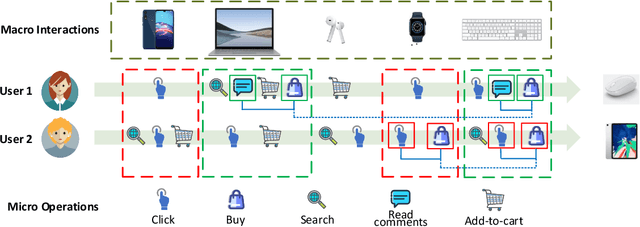
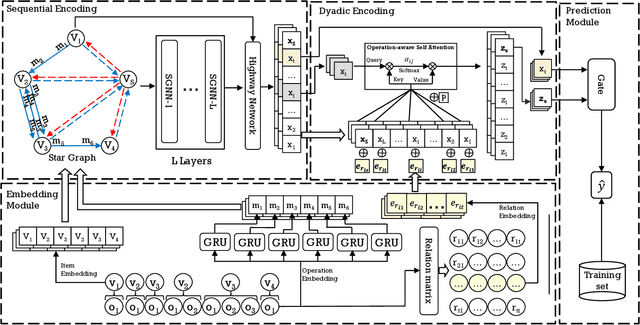
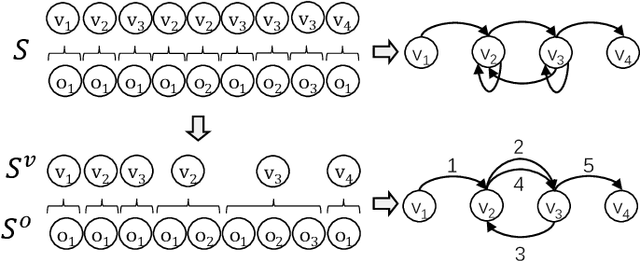

Abstract:Session-based Recommendation (SR) aims to predict the next item for recommendation based on previously recorded sessions of user interaction. The majority of existing approaches to SR focus on modeling the transition patterns of items. In such models, the so-called micro-behaviors describing how the user locates an item and carries out various activities on it (e.g., click, add-to-cart, and read-comments), are simply ignored. A few recent studies have tried to incorporate the sequential patterns of micro-behaviors into SR models. However, those sequential models still cannot effectively capture all the inherent interdependencies between micro-behavior operations. In this work, we aim to investigate the effects of the micro-behavior information in SR systematically. Specifically, we identify two different patterns of micro-behaviors: "sequential patterns" and "dyadic relational patterns". To build a unified model of user micro-behaviors, we first devise a multigraph to aggregate the sequential patterns from different items via a graph neural network, and then utilize an extended self-attention network to exploit the pair-wise relational patterns of micro-behaviors. Extensive experiments on three public real-world datasets show the superiority of the proposed approach over the state-of-theart baselines and confirm the usefulness of these two different micro-behavior patterns for SR.
Community Trend Prediction on Heterogeneous Graph in E-commerce
Feb 24, 2022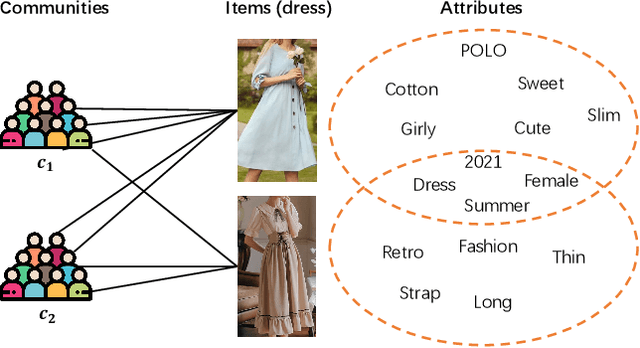

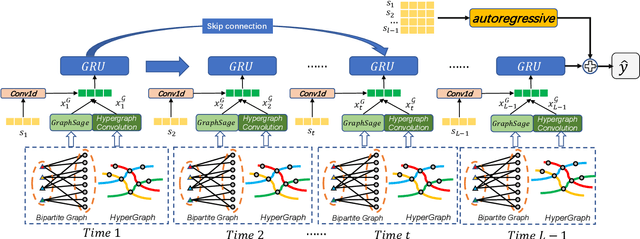

Abstract:In online shopping, ever-changing fashion trends make merchants need to prepare more differentiated products to meet the diversified demands, and e-commerce platforms need to capture the market trend with a prophetic vision. For the trend prediction, the attribute tags, as the essential description of items, can genuinely reflect the decision basis of consumers. However, few existing works explore the attribute trend in the specific community for e-commerce. In this paper, we focus on the community trend prediction on the item attribute and propose a unified framework that combines the dynamic evolution of two graph patterns to predict the attribute trend in a specific community. Specifically, we first design a communityattribute bipartite graph at each time step to learn the collaboration of different communities. Next, we transform the bipartite graph into a hypergraph to exploit the associations of different attribute tags in one community. Lastly, we introduce a dynamic evolution component based on the recurrent neural networks to capture the fashion trend of attribute tags. Extensive experiments on three real-world datasets in a large e-commerce platform show the superiority of the proposed approach over several strong alternatives and demonstrate the ability to discover the community trend in advance.
 Add to Chrome
Add to Chrome Add to Firefox
Add to Firefox Add to Edge
Add to Edge